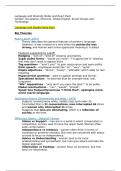Language and Diversity Notes and Exam Pack
Gender, Occupation, Ethnicity, Global English, Social Groups and
Technology
Language and Gender Note Pack
Big Theories
Robin Lakoff (1975)
- Theory describes the general features of women’s language.
However, it was created at a time when the patriarchy was
strong, and women were more oppressed meaning it is dated.
Features suggested by Lakoff:
Hedging – “sort of”, “kind of” showing uncertainty.
Super polite forms – “would you mind”, “I’d appreciate it” showing
that they don’t want to appear blunt.
Tag questions – “aren’t you?” to gain reassurance and seem polite.
Italic speech – emphasise words like “so”, “very”, “quite”.
Empty adjectives – “divine”, “lovely”, “adorable” which adds no real
meaning.
Hypercorrect grammar – want to appear prestige and formal.
Specialised lexicon – to describe blue for example (teal, teal,
turquoise).
“Wh” imperatives – “why don’t you open the door?” to be polite.
Modal constructions – “can”, “would”, “should”.
Speak less frequently/overuse “I think that”, apologise more,
avoid coarse language.
Dominance theory (Zimmerman and West – 1975)
- Subjects involved were white, middle class and under 35.
- Concluded that in 31 conversations, men interrupted 46 times
and women only interrupted 11 times.
- Suggests that men are dominating, which is a reflection of
society at the time.
Difference theory – Deborah Tannen
Status vs Support – men are in a world in which conversation is
competitive, so they seek to have the upper hand. Women often
seek conformation.
Independence vs Intimacy – women often think in terms of
closeness to preserve intimacy. But men are concerned with status
so tend to focus on independence.
Advice vs Understanding – women tend to be more
understanding and sympathetic, but men give advice and take the
logical approach.
Information vs Feelings – women focus on emotions, but men
focus on information.
, Orders vs Proposals – women use “lets” or “why don’t we?”,
whereas men are more likely to use direct imperatives.
Conflict vs Compromise – women will not openly go against
something, but men are most likely to go against something and
cause conflict.
Jennifer Coates and Deborah Tannen (1990)
- Looked at how women speak; this theory looks more into the topic
rather than the actual lexical usage.
Features Coates and Tannen identified
House talk – the exchange of information about being the
“female”.
Scandal – judging the behaviour of others; usually women, related
to scandals about domestic morality.
Bitching – women’s anger at their restricted role and inferior
status. Usually done in private to other women.
Chatting – intimate form of gossip, talking about their thoughts and
feelings with each other.
Small Theories
Fisherman (1990)
- Suggest that women ask questions because of the power of
them, not because they are weak. Men speak on average for twice
as much as women.
Holmes (1992)
- Suggests that tag questions are used to be polite and used to keep
a conversation going.
Dubois and Crouch (1975)
- Found that men use more tag questions.
Trudgill (1970)
- Found that women are more likely to use hypercorrectness to
appear ‘posh’ and part of a higher social class.
- However, men are more likely to use less prestigious grammar
to appear ‘tough’ or ‘down to earth’.
Jenny Cheshire – The Reading Study
- In nearly all cases, the boys interviewed used more non-standard
forms than girls.
- She suggested that boys are members of much denser social
networks, in which their language was converged towards each
other.
Jane Pilkington (1992)
- Found that women in same sex talk were more collaborative.
, Other Key Ideas
Julia Stanley
- Found that there were 220 words/terms denoting sexual
promiscuity for women, compared to 26 for men.
Marked terms
- Words with a gendered term attached to them. Example – “man-
whore” as opposed to “whore”. We unconsciously refer to males
even when talking about women (“two-man tent”, “may the best
man win”, “man up”).
Anne Bodine (1975)
- Bias in the English Language in favour of males is known as
androcentric language.
Gender Polarisation (Sandra Bem)
- Gender polarisation is a concept which states that societies tend to
define femininity and masculinity as polar opposite genders. It
states that certain behaviour and attitudes are acceptable for men
but not seen as appropriate for women.
Gender Dichotomy
- A term used to show there is differences between men and women
(biologically, socially and linguistically).
Liz Hodgkinson
- Suggests that women shouldn’t change their name when
marrying a man and it should be a mixture of both parties. E.g. one
child gets one name and the other child gets the other name. She
suggests that it’s similar to slavery in America, that you could lose
your identity if you change it and says it’s old fashioned.
The Bechdel test
- This judges whether a piece of work (book, film, theatre, TV) has;
two women who talk to each other about something other than a
man.
Language and Gender Exam Pack (45 mins, 30 marks, 10 AO1, 20 AO2)
Paragraph 1
- Introduce the question; use terms such as ‘gender dichotomy’ and
‘androcentric’ to define gender and the societal ideals behind it.
Establish a clear viewpoint.
Paragraph 2
- Introduce your first point in favour of gender. Immediately refer to
a theory and use examples and framework to back up the




